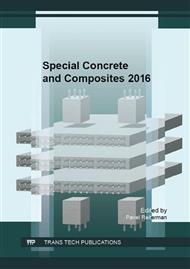p.87
p.92
p.100
p.108
p.113
p.121
p.126
p.132
p.140
Synergistic Effect of High Temperature Fly Ash with Fluidized Bed Combustion Fly Ash in Cement Composites
Abstract:
Using high temperature fly ash for his pozzolan properties to cement composite production is known a few years ago. New ways combustion of fossil fuels also creates a new type of fly ash, named fluidized bed combustion fly ash. However, this fly ash has same pozzolan properties as has high temperature fly ash, this type is not using for production of cement composites. Fluidized bed combustion fly ash has highly variable chemical composition but usually it has a higher amount of free CaO together with sulphates. This higher amounts of free CaO after mixing of fluidized bed combustion fly ash with water to some extent becomes an activator for the beginning of the pozzolanic reaction, during which is consumed the extinguished CaO. If there is also present high temperature fly ash in cement composite, it could be accelerated his pozzolanic reaction in the same manner using a fluidized bed combustion fly ash. In this experiment was tested a synergy effect in the use of fluidized bed combustion fly ash with high temperature fly ash as an additive. The experiment was carried out on cement pastes that have been studied in particular the progress of hydration processes, pointing to a possible acceleration of pozzolanic reactions of both types of fly ash.
Info:
Periodical:
Pages:
113-118
Citation:
Online since:
December 2016
Authors:
Price:
Сopyright:
© 2017 Trans Tech Publications Ltd. All Rights Reserved
Share:
Citation:


